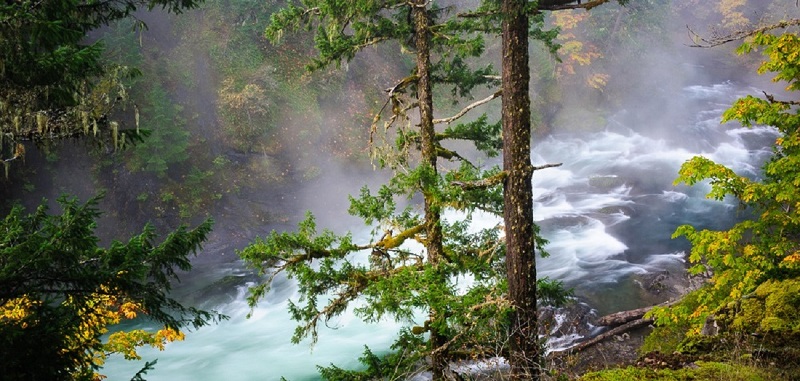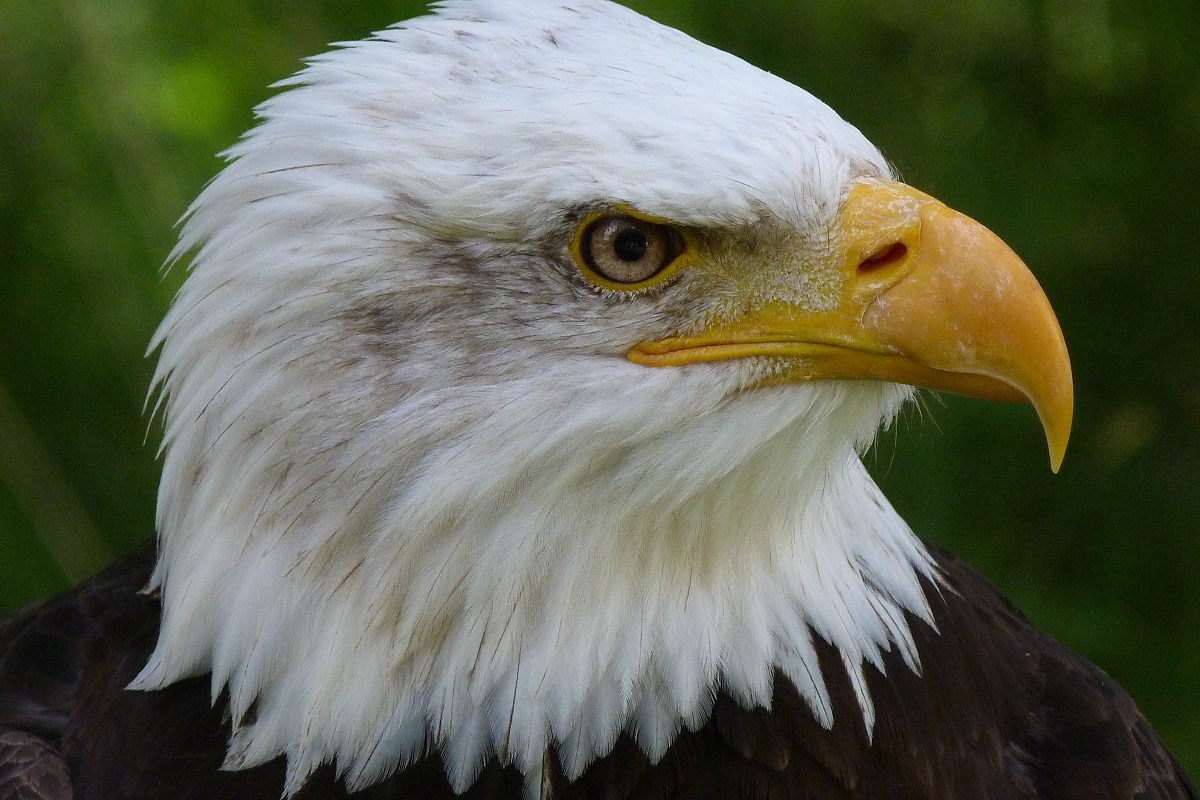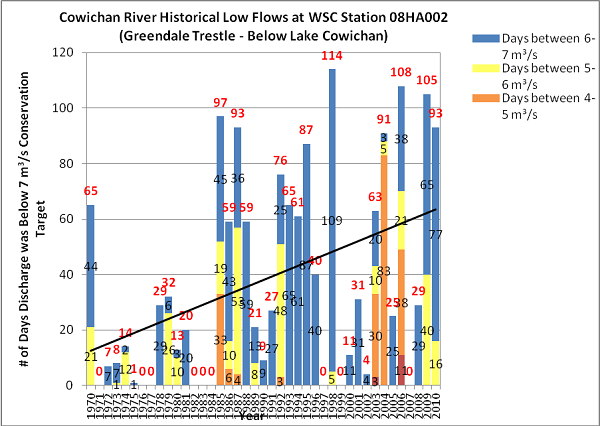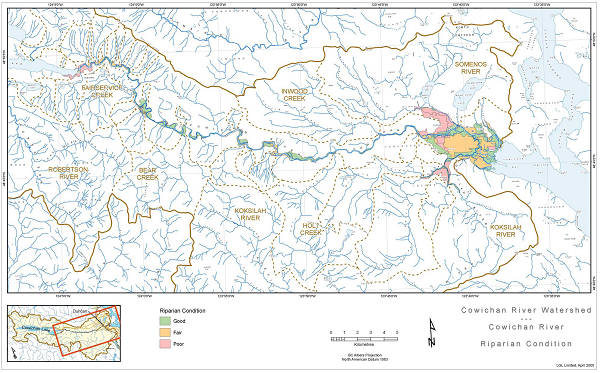Action Plan For Rebuilding Cowichan Chinook
The Cowichan Watershed Health and Chinook Initiative, is the foundation for a collective and integrated management effort focused on Chinook abundance and supporting robust fish stocks in a healthy watershed.
In order to maximize chinook productivity in fresh and salt-water environments, efforts in harvest management, hatchery supplementation, research and monitoring and education and public outreach will be required. The Cowichan Chinook Initiative is based on current research about the relationships between watershed processes, land-use and fresh-water habitats affecting watershed health. Marine influences, including climate change, oceanic influences and marine fish harvest are also considered.
Each of the key watershed health attributes establishes and describes goals the strategy is trying to achieve. Recommended Actions describe efforts to be made by interested parties, aimed at achieving Initiative goals and, thereby, increase the likelihood of more robust chinook populations in the Cowichan River system over time.
Focusing on achieving these goals will focus on maximizing returns and spawning success while also allowing healthy, robust smolts entering the estuary a much better chance of surviving challenges they will face in the ocean. Ensuring chinook abundance will require a focus on decreasing mortality or critical limiting factors in fresh-water. The Chinook Initiative describes a recommended series of actions that, if taken, are likely to increase the number of returning adults and the survival of their offspring, and thereby continue to re-build Cowichan chinook populations into the future (Figure 10). Detailed action plans proposed for each Critical Limiting Factor can be found summarized later in this document or in detail at the following hyperlink here.
Cowichan Chinook Vision
The Vision Statement for Cowichan Chinook is described as A healthy, spatially diverse return, in timing and distribution, of spring-summer and fall timed chinook adults to the spawning grounds, with enough to support vibrant Cowichan Tribes and other fisheries.
The current DFO escapement goal for Cowichan fall chinook is 6,500. In times of low marine survival the Cowichan Recovery Plan proposes the escapement goal should be 8,000 for spawning and 4,000 for hatchery broodstock. An escapement goal for spring run chinook has not been set.
Proposed management actions were categorized to address both watershed health pressures or threats and chinook limiting factors
directly or indirectly in the river, estuary and marine environments, and will require technical and management review. The actions
are proposed as a starting point, where re-building Cowichan chinook stocks is a collaborative focus to achieve watershed health
as a means to address chinook production, providing a win-win all around.
Management actions will be prioritized based on:
- Benefit to watershed health goals and/or mitigation of chinook critical limiting factors.
- Available resources and funding.
- a champion to lead the action.
An implementation strategy is proposed below.

Freshwater Habitat Health Actions
Actions to improve watershed and habitat health may flow out of larger scale programs, plans, acts, policies, and regulations, such as:
- Sustainable Forest Management Plans include hydrological assessments and riparian protection, large-woody debris recruitment etc.
- Local government land-use and infrastructure plans
- Transportation and infrastructure plans
- Cowichan River Parks Plan
- Riparian Area Regulation
- Fisheries Act
- Cowichan Estuary Management Plan
- Cowichan Tribe Land-use and Community Plans
- Forest and Range Practices Act
- Riparian Areas Protection Act
Specific actions will generally be small scale site-specific or project-level actions aimed at enhancement and restoration of key and critical habitats; near-stream and floodplain management actions; and conservation easements and willing seller park additions. These are summarized below. Detailed actions related to each Watershed Goal and Critical Limiting Factor can be found in the summary table or in the 2-page action plans appended to this report.
Habitat Protection, Restoration or Enhancement Actions The Cowichan Watershed is large and complex and attributes such as physical habitat and hydrology have been influenced greatly due to land-use and climate change. The CVRD, Cowichan Tribes and other levels of government have been focused on understanding these changes. Hydrological models have been developed for the watershed but still remain un-tested and much is in flux around our state of knowledge of the watershed and its attributes or future climate influences. Broad-scale hydrologic restoration projects will require additional information such as:
- Additional lake water storage needs to buffer climate change impacts
- Forest hydrology impact studies
- Assessing ground-water resources, influences on Cowichan and Koksilah river flows and understanding supply and demand metrics
The Cowichan River and salmon have been a focus for many studies over the years. This wealth of knowledge provides a good basis for action. A summary of recommendations from habitat and specific chinook research can be found here. In addition, some key habitat restoration projects have been completed in the Cowichan to date (a complete list can be found here).
Other recommended riparian restoration and protection projects include:
- Digitizing maps from the year 1890 on to review and quantify true changes in riparian systems on the Cowichan and Koksilah rivers
- Conducting riparian assessments and engaging in restoration planning for the Lower Cowichan River
- Working with the Cowichan Diking Authority to restore and re-plant riparian edge environments
- Conducting an Invasive Species Inventory and organizing efforts for their removal
- Including riparian protection strategies in land-use plans for Cowichan Tribes and local governments.
Other recommended riverline restoration and protection projects include:
- Providing adequate in-stream large wood debris (LWD)
- Assessing critical habitat including estuary, in-river pools, riffles and LWD and restoring habitat complexity and estuary cover
- Providing access to historical off-channel habitat, especially in the lower river
- Managing accumulated sediments in lower river (follow CVRD Sediment Management Plan)
- Assessing and restoring spawning habitat in upper river and Cowichan Lake tributaries
Near stream and flood plain management Detailed actions for the near-stream zone around the Cowichan and Koksilah will be available upon completion of the Cowichan/Koksilah Chinook Critical Habitat Inventory being conducted by Cowichan Tribes. The Cowichan/Koksilah Integrated Flood Management Plan and subsequent sediment management plan outlines many actions related to restoration of the flood plain.
Conservation Easements and 'Willing Seller' Park Additions - Local governments are encouraged to prioritize retention of riparian and key hydrological areas as either conservation easements or park additions. The Cowichan Valley Land Trust and other environmental non-government organizations are encouraged to work with land-owners to establish conservation easements and a stewardship ethic on their own properties.
Predation Management Actions
Managers and interest groups know that adult and fry predation is ranked as a very high critical limiting factor to supporting robust Cowichan River Chinook populations. However, a breadth of knowledge is still needed in-terms of understanding the full impact of predation on Cowichan Chinook in the river and estuary environments.
Pinnepeds in the estuary and the lower river are thought to target adult Chinook, especially females, during staging before migrating up the river and as smolts enter the estuary. Key actions required to understand, quantify and minimize predation by other carnivorous marine mammals include:
- Conducting/Updating a Chinook Habitat Assessment in the Cowichan Estuary
- Quantifying the number and predation rate of pinnepeds on adult and juvenile Chinook (Cowichan Tribes estuary predation project; UBC Marine Mammal Lab research in the Strait of Georgia; Salish Sea Marine Survival Project)
- Assess and engage stakeholders to manage and minimize the impacts of log booms in the estuary.
Predation of eggs, fry and smolts by fish, amphibians and birds is also being studied in the Cowichan River that will provide a sense of natural losses that occur in the riverine ecosystem.
Proposed:
- Complete the Brown Trout Predation Study in the Cowichan River
Fisheries Management Actions
Cowichan chinook are distributed throughout southern BC and into Washington State. The annual distribution varies, likely based on marine conditions, food availability, etc.. The following actions have been implemented in ocean fisheries to reduce impact on Cowichan chinook, including:
- Size limit restriction in the Strait of Georgia recreational fishery
- Approximately 50% reduction to the WCVI commercial troll fishery for chinook
- Spot closures throughout the northern Strait of Georgia recreational fishery
- size and daily limit restriction from March to July in the Victoria area and southern Strait
- a terminal area 'Gulf Islands' closure extending from Nanaimo down to Saanich during August-October
At this time there are no management actions specific to red, amber, or green status zones as described in the Wild Salmon Policy. These actions apply to all status levels.
Cowichan Tribes have unilaterally reduced take for food and ceremonial (FSC) purposes during periods of low water and concern for chinook migration. Other fisheries within the Cowichan Bay and river are managed under the auspices of the Cowichan Harvest Roundtable.
Future fishery management actions will be informed and influenced by strategies developed as part of the Southern BC Chinook Strategic Planning Initiative (SPI). The Cowichan Chinook stocks are included within this initiative.
Hatchery Supplementation Actions
The Cowichan River Hatchery has been operated by the Cowichan Tribes under contract to Fisheries and Oceans Canada (DFO) as part of the Salmonid Enhancement Program (SEP) since 1978. Within the SEP Community Economic Development Program (CEDP) the hatchery was initially established to achieve a range of objectives that included salmon enhancement, providing employment, obtaining stock information, contributing to the local economy, and improving relations between the Federal government and the Cowichan Tribes. The Cowichan River Hatchery has the objective to support re-building of Cowichan Chinook and assessment as an indicator stock for the Pacific Salmon Treaty.
DFO guidance on the hatchery operations which have the objective of rebuilding or maintaining natural stocks is to:
- Limit broodstock collection to less than 30% of the returning spawners. The current hatchery egg target is 700,000 chinook eggs. This target has been reduced from over 3M in the early 1990s to ensure SEP guidance is being followed. Over the full period, the 30% guide for broodstock collection was exceeded 6 out of 29 years (21%) presented in Figure 5. One of those years, 2008, was near 50% removal due to the extremely low run size. Over the most recent 5 years, on average less than 10% of the total spawners (natural spawners plus hatchery brood) were removed for brood stock.
- Limit hatchery returns to less than 50% of the return. The percent contribution of hatchery origin chinook to the chinook natural spawners has averaged about 29% of the annual return.
The question arises as to the degree to which hatchery production benefits the river spawners. The following graph indicates that there is considerable variability in the hatchery returns. About 80% of the time the returns were equal to or more than the numbers taken for brood stock. On average hatchery returns are about 46% greater than the broodstock taken.
Proposed actions involving the Hatchery include:
- Continue to adhere to DFO Fish Enhancement Guidelines (no more than 30% of an expected annual return of fish shall be captured from the river for the hatchery and no more than 50% of the return shall be of hatchery origin)
- Work towards improved fish homing using river water
- Test and refine fry release strategies to improve survival rates
- Passive Intregrated Transponder (PIT) Tagging Studies to monitor release strategy success and gather information on life stage mortality
Research and Monitoring Actions
Research: The following key knowledge gaps were identified during the Critical Limiting Factors Expert reviews in 2013 and 2016:
- Lack of knowledge regarding the available food supply and rearing capacity in the Cowichan Estuary as well as identification of key and critical habitat to protect and restore for Chinook production
- Quantify the amount of aquatic rearing habitat that has been lost in the lower river over time
- Estimations of annual freshwater juvenile production on an annual basis for fall Chinook (egg to fry survival, fry to smolt survival and hatchery effectiveness) to determine how many wild and hatchery Chinook are currently entering the marine environment. This was also highlighted as an important action item and assessment tool in the 2005 Cowichan Recovery Plan (LGL 2005)
- Lack of information and focus on the spring Chinook run in the Cowichan River, including genetic distinctness, distribution in the watershed, current abundance key migration period and rebuilding potential
- Lack of information regarding the existing and potential use of the Koksilah River by Chinook
- Uncertainty of the density dependent effects of large hatchery releases of Chinook fry on the survival rates of wild raised Chinook fry
- Increase understanding of threats and limiting factors affecting juvenile survival in estuary and early marine habitats, especially in the Strait of Georgia and WCVI, and mitigate these factors where possible (link to Southern BC Chinook Strategic Planning Initiative)
- Uncertainty on the impacts of aquatic invasive plant species to fish access, cover rearing and passage, including invasive plants in riparian areas
- Some of the CLFs that affect fall run Chinook likely impact early run Chinook as much or even more: for example, low summer flows, woody debris, gravel, log jams, water temperature, etc.
- What flows are required to allow for appropriate sewage dilution
- 2014 and 2015 were very different years but there were still large numbers of fish in the bay. It would be useful to see how fish behave with each incremental drop in flows
- What accounts for the high level of in-river juvenile mortality as evidenced by the BCCF PIT tagging studies and DFO’s Rotary Screw Trap Studies
Monitoring
- Review of Critical Limiting Factors every 2 years
- Update knowledge gaps filled each year
- Partners to review action items, update based on critical factors review and prioritize
Education and Outreach Actions
Best Management Practices a number of BMPs exist for local government, developers and citizens for protecting fish and fish habitat.
- Create a list of BMPs that are easily accessible for planners and citizens






























